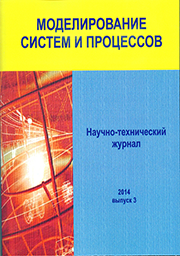Ivanovo, Ivanovo, Russian Federation
Russian Federation
For the mathematical description of hydrodynamic conditions in industrial equipment, idealized models are usually used. Upon receipt, a number of simplifying assumptions are made, which, on the one hand, facilitate the use, and on the other hand, the Appearance of the adequacy of the model. All typical models of flow structures are deterministic and continual. At the same time, it became known that the real situation arises in the process of considering possible factors. This trend leads to the need for a wider application of probabilistic approaches to modeling technological processes and apparatuses using modern digital technologies. This article cancels an attempt to create a hydrodynamic model using probabilistic cellular automata. In the model of occurrence, there is one reason for two flow velocities, a decision on the occurrence of a pressure drop, and the other is due to random walks of microvolumes of a moving medium. The described procedure for creating a model contains the results of its use. In particular, the results of modeling of motion trajectories in rare cases, the phenomena of their general movement and detection in rare zones were found. The article presents the results of a comparison of a discrete stochastic model with the types of a diffusion model, in terms of reflecting the physical essence of current flows, the possibilities of determining parameter models, and ease of use. The decisive aspects of the new model, its advantages and revolutions are shown. Possible areas of application of the obtained model. Under investigation are the results of simulation modeling using the proposed model, which reveal repeated results not only consistent with the classical approaches of hydrodynamics, but allow obtaining new data on the course of the processes under study.
Discrete modeling, flow hydrodynamics, probabilistic cellular automata.
1. Processy i apparaty himicheskoy tehnologii. V 5 t. T. 1. Osnovy teorii processov himicheskoy tehnologii / D.A. Baranov [i dr.] ; god.red. A.M. Kutepova. - M. : Logos, 2000. - 480 s.
2. Loycyanskiy, L.G. Mehanika zhidkosti i gaza / L.G. Loycyanskiy. - M. : Nauka, 1987. - 840 s.
3. Ivanov, B.N. Mir fizicheskoy gidrodinamiki / B.N. Ivanov. - M. : URSS, 2010. - 240 s.
4. Zavaruhin, S.G. Matematicheskoe modelirovanie himiko-tehnologicheskih processov i apparatov / S.G. Zavaruhin. - Novosibirsk : Izd-vo NGTU, 2017. - 86 s.
5. Efremov, G.I. Modelirovanie himiko-tehnologiches-kih processov / G.I. Efremov. - M.: INFRA-M, 2021. - 260 s.
6. Gumerov, A.M. Matematicheskoe modelirovanie himiko-tehnologicheskih processov : ucheb. posobie / A.M. Gumerov. - Sankt-Peterburg : Lan', 2022. - 176 s.
7. Nekrasov, A.V. Komp'yuternoe modelirovanie gidrodinamicheskih processov sistem vodosnabzheniya / A.V. Nekrasov. - Ekaterinburg : Izd-vo Ural. un-ta, 2014. - 312 s.
8. Kafarov, V.V. Sistemnyy analiz processov himicheskoy tehnologii / V.V. Kafarov, I.N. Dorohov. - M. : Yurayt, 2018. - 499 s.
9. Bandman, O.L. Kletochno-avtomatnye modeli estestvennyh processov i ih realizaciya na sovremennyh komp'yuterah / O.L. Bandman // Prikladnaya diskretnaya matematika. - 2017. - № 35. - S. 102-121. - DOI:https://doi.org/10.17223/20710410/35/9.
10. Ershov, N.M. Diskretnoe modelirovanie s pomosch'yu stohasticheskih kletochnyh avtomatov / N.M. Ershov, A.V. Kravchuk // Vestnik Rossiyskogo universiteta druzhby narodov: Ser. Matematika, informatika, fizika. - 2014. - № 2. - S. 359-362.
11. Bobkov, S.P. Primenenie agentnogo podhoda dlya modelirovaniya processov teploprovodnosti / S.P. Bobkov, I.A. Astrahanceva // Vestnik IGEU. - 2022. - №. 2. - S. 58-66.
12. Bandman, O. Relationships between cellular automata model parameters and their physical counterparts / O. Bandman // Bulletin of the Novosibirsk Computing Center, Series: Computer Science. - 2018. - I. 42. - P. 1-14. - DOI:https://doi.org/10.31144/bncc.cs.2542-1972.2018.n42.p1-14.
13. Bobkov, S.P. Primenenie sistemnogo podhoda pri razrabotke matematicheskih modeley / S.P. Bobkov, I.A. Astrahanceva, E.G. Galiaskarov // Sovremennye naukoemkie tehnologii. Regional'noe prilozhenie. 2021. - №1(65). - S. 66-71. - DOI:https://doi.org/10.6060/snt.20216501.0008.
14. Bobkov, S.P. Modelirovanie processa teploprovodnosti s ispol'zovaniem sistem kletochnyh avtomatov / S.P. Bobkov, E.G. Galiaskarov // Programmnye produkty i sistemy. - 2020. - № 4. - S. 641-650. -DOIhttps://doi.org/10.15827/0236-235X.132.641-650.
15. Bobkov, S.P. The use of multi-agent systems for modeling technological processes / S.P. Bobkov, I.A. Astrakhantseva // Journal of Physics: Conference Series. - 2021. - T. 2001. - S. 012002. - DOI:https://doi.org/10.1088/1742-6596/2001/1/012002.
16. Ershov, N.M. Estestvennye modeli parallel'nyh vychisleniy / N.M.Ershov , N.N. Popova // Komp'yuternye issledovaniya i modelirovanie. - 2015. - T. 7, № 3. - S. 781-785. - DOI: https://doi.org/10.20537/2076-7633-2015-7-3-781-785.
17. Bobkov, S.P. Use of Discrete Approaches for Simulation the Basic Processes of Chemical Technology / S.P. Bobkov // Russian Journal of General Chemistry. - 2021. - V. 91, № 6. - Pp. 1190-1197. - DOI:https://doi.org/10.1134/S1070363221060311.
18. Bekman, I.N. Matematicheskiy apparat diffuzii / I.N. Bekman. - M. : Yurayt, 2017. - 459 s.
19. Kirichenko, N.A. Termodinamika, statisticheskaya i molekulyarnaya fizika / N.A. Kirichenko. - M. : Fizmatlit, 2012. - 192 s.








